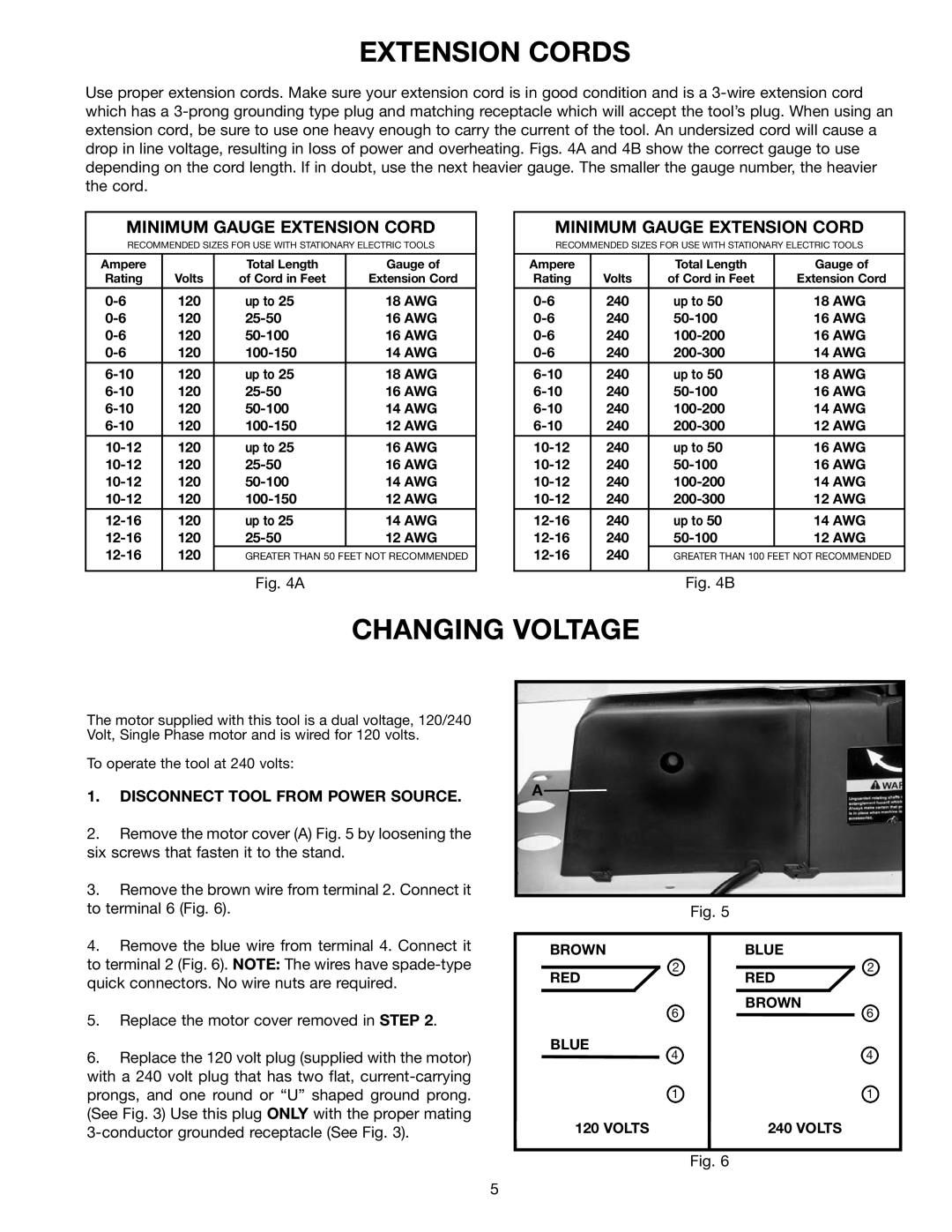
EXTENSION CORDS
Use proper extension cords. Make sure your extension cord is in good condition and is a
MINIMUM GAUGE EXTENSION CORD
RECOMMENDED SIZES FOR USE WITH STATIONARY ELECTRIC TOOLS
Ampere |
| Total Length | Gauge of |
Rating | Volts | of Cord in Feet | Extension Cord |
|
|
|
|
120 | up to 25 | 18 AWG | |
120 | 16 AWG | ||
120 | 16 AWG | ||
120 | 14 AWG | ||
120 | up to 25 | 18 AWG | |
120 | 16 AWG | ||
120 | 14 AWG | ||
120 | 12 AWG | ||
|
|
|
|
120 | up to 25 | 16 AWG | |
120 | 16 AWG | ||
120 | 14 AWG | ||
120 | 12 AWG | ||
|
|
|
|
120 | up to 25 | 14 AWG | |
120 | 12 AWG | ||
120 | GREATER THAN 50 FEET NOT RECOMMENDED | ||
|
|
|
|
Fig. 4A
MINIMUM GAUGE EXTENSION CORD
RECOMMENDED SIZES FOR USE WITH STATIONARY ELECTRIC TOOLS
Ampere |
| Total Length | Gauge of |
Rating | Volts | of Cord in Feet | Extension Cord |
|
|
|
|
240 | up to 50 | 18 AWG | |
240 | 16 AWG | ||
240 | 16 AWG | ||
240 | 14 AWG | ||
240 | up to 50 | 18 AWG | |
240 | 16 AWG | ||
240 | 14 AWG | ||
240 | 12 AWG | ||
|
|
|
|
240 | up to 50 | 16 AWG | |
240 | 16 AWG | ||
240 | 14 AWG | ||
240 | 12 AWG | ||
|
|
|
|
240 | up to 50 | 14 AWG | |
240 | 12 AWG | ||
240 | GREATER THAN 100 FEET NOT RECOMMENDED | ||
|
|
|
|
Fig. 4B
CHANGING VOLTAGE
The motor supplied with this tool is a dual voltage, 120/240 Volt, Single Phase motor and is wired for 120 volts.
To operate the tool at 240 volts:
1.DISCONNECT TOOL FROM POWER SOURCE.
2.Remove the motor cover (A) Fig. 5 by loosening the six screws that fasten it to the stand.
3.Remove the brown wire from terminal 2. Connect it to terminal 6 (Fig. 6).
4.Remove the blue wire from terminal 4. Connect it to terminal 2 (Fig. 6). NOTE: The wires have
5.Replace the motor cover removed in STEP 2.
6.Replace the 120 volt plug (supplied with the motor) with a 240 volt plug that has two flat,
A
| Fig. 5 |
BROWN | BLUE |
2 | 2 |
RED | RED |
6 | BROWN |
6 | |
BLUE | 4 |
4 | |
1 | 1 |
120 VOLTS | 240 VOLTS |
Fig. 6
5
